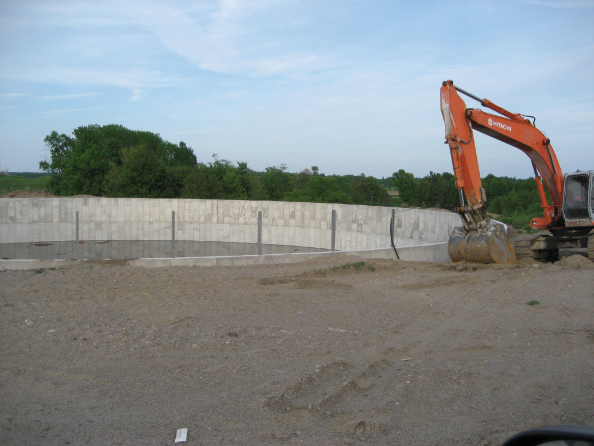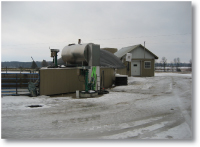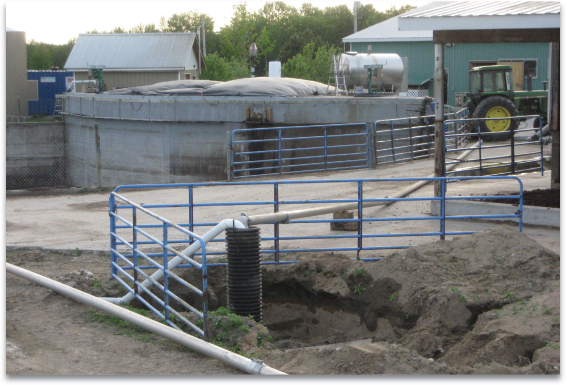
Second digester being added at Canadian dairy this year
 |
| Canadian manure management pioneers Paul and Fritz Klaesi are in the midst of a major expansion of their farms’ bio-digester, which is expected to be completed by the end of the year. |
Second digester being added at Canadian dairy this year
Canadian manure management pioneers Paul and Fritz Klaesi, who share a bio-digester between their dairy farms near Cobden (northwest of Ottawa), are in the midst of a major expansion. Construction of a second, much larger digester should be finished by the end of the year.
About 20 years ago, the brothers moved with their families to Canada from Switzerland, where biogas technology is increasingly common and produces a significant amount of the country’s electricity.
The original digester was imported from Europe and cost $280,000 to install in 2003, although Paul Klaesi, an electrical engineer, and other family members contributed hundreds of hours towards the design and installation of the system not included in that cost. The anticipated payback was 10 years.
The system’s generator inputs electricity to the grid around the clock, and the farms draw from the grid twice daily during milking when their power demand is high, so that the Klaesis have been billed only for net power used. The heat from the generator also provides supplemental winter heat to buildings on both farms.
At the start, the digester generated 400 cubic metres of methane and produced 750 kilowatt hours of electrical power per day – more than enough to meet the energy needs of both farms and their two houses.
Last year, however, two significant changes occurred. In May 2007, the Klaesis finally received a Certificate of Approval from the Ontario Ministry of the Environment, allowing them to accept off-farm food wastes – commonly known as grease – into their digester. These wastes include deep-fryer grease, dishwasher residue, meal leftovers and food preparation wastes. Receiving the permit took more than 18 months, and that process is currently being streamlined.
In addition, in October 2007 the Klaesis signed an Ontario Power Authority (OPA) Renewable Energy Standard Offer Program Contract and Option Agreement. OPA, the agency controlling power generation in Ontario, has made this offer available to anyone generating renewable energy (from wind, biomass or bio-digesters) who wishes to contribute to the province’s electricity grid for payment. The rate currently sits at 11¢ per kW, with a 3.5¢ bonus per kW for contributions made during peak electricity demand times.
 |
| In May 2007, the Klaesis received approval from the Ontario Ministry of the Environment to accept off-farm food wastes – commonly known as grease – into their digester. |
With the signing of this agreement and the incorporation of grease, “We now buy no power from the grid and sell three times what we use,” said Klaesi. “Some power flows back into the farm at peak milking time, which amounts to about $130 per month.”
Before they had a digester, the monthly electricity bill for the farms was $2,500.
At the same time, Klaesi does not believe the OPA contract rate supports digester cost-return adequately. He and about 30 other farmers have formed an association, called the Agri-Energy Producers Association of Ontario, to lobby the government for a boosted rate. The OPA has a rate review scheduled for this fall.
“We haven’t had a ‘yes’ yet,” says Klaesi, “but they understand our concerns.”
Expansion
A new digester is currently being built alongside the original one for several reasons. Klaesi says one of the biggest advantages of having a second digester will be that all the farm’s manure will be “covered” – placed directly in their digester system – which means no open pit with associated odors. (The existing open manure storage pit must remain, however, as Ontario’s Nutrient Management Act specifies that each farm must be able to store 240 days’ worth of manure.)
Genesys Biogas Inc. of Ottawa, Ont., is doing most of the design work for the expansion and will assist in the construction. Genesys engineer Benjamin Strehler, who was also involved in the design and installation of the Klaesis’ original digester, says the new digester is similar to the old: continuous flow with twice-daily mixing and heated concrete walls. It will have a retention time of about 50 days, which is about double the original digester.
Manure from the 140 cattle in the dairy barn will continue to be placed into the original digester twice a day. The grease – delivered every three to four days, placed in a 50 m3 in-ground storage tank and pasteurized daily in 13 m3 batches for one hour at 70˚C (158˚F) – will be placed into the old and new digesters in a 1:2 ratio.
 |
| One of the biggest advantages of having a second digester will be that all the farm’s manure will be placed directly in their digester system, meaning no open pit with associated odors. |
The old digester accepts 25 to 30 percent grease and 70 to 75 percent manure while the new one will accept 40 percent grease and 60 percent manure mixture that has already been through the first digester. Because the new digester is four times as large as the original (500 m3 versus 2000 m3), and because it accepts a greater proportion of grease, Strehler says it will be able to produce a whopping 10-times more energy than the original. The farm’s 500-kW generator will eventually be replaced with a 2000-kW engine.
In terms of payback for the new digester, Strehler is optimistic it will occur within about seven years. However, this cost-return estimate could be lengthened if the Klaesis have to pay for off-farm waste. Right now, the grease is delivered at no charge by a company called Organic Resources, which is paid to collect it from restaurants.
Strehler admits that while it’s a possibility that digester operators like the Klaesis may have to pay for grease sometime in future, he says “I don’t think it’ll be anytime soon.” He says restaurant wastes present a problem for municipalities whether they process it with sewage or send it to their landfills. “Grease is a nuisance that a lot of people are glad to get rid of,” he says, pointing out that Klaesis have had inquiries about accepting grease from as far away as Toronto.
Genesys expects construction of at least other two digester projects in Eastern Ontario to proceed this year (dairy and hog) and it could be even more than that, says Strehler.
“There is lots of interest now,” he concludes.